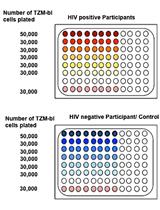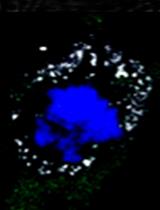- EN - English
- CN - 中文
In vitro Assays for Measuring Endothelial Permeability by Transwells and Electrical Impedance Systems
利用Transwell试验和电阻抗系统体外测量内皮通透性
发布: 2017年05月05日第7卷第9期 DOI: 10.21769/BioProtoc.2273 浏览次数: 27884
评审: Yannick DebingKate HannanChris Tibbitt

相关实验方案

TZA, 一种基于敏感报告因子细胞学检测方法, 可用于准确快速量化静息CD4+ T细胞中可诱导的且复制能力强的潜伏HV-1
Anwesha Sanyal [...] Phalguni Gupta
2019年05月20日 7730 阅读
Abstract
Vascular leakage is an important feature in several diseases, such as septic shock, viral hemorrhagic fever, cancer metastasis and ischemia-reperfusion injuries. Thus establishing assays for measuring endothelial permeability will provide insight into the establishment or progression of such diseases. Here, we provide transwell permeability assay and electrical impedance sensing assay for studying endothelial permeability in vitro. With these methods, the effect of a molecule on endothelial permeability could be defined.
Keywords: Endothelial permeability (内皮通透性)Background
The endothelial barrier is a well-regulated structure, which maintains a minimal and selective permeability to fluid and molecules under normal physiological conditions (Komarova and Malik, 2010). The disruption of the endothelial barrier occurs during exposure to inflammatory cytokines, pathogen infection, or cancer metastasis, which induces the disruption of cytoskeleton, cell-cell junction, or cell-to-matrix attachments. The increase in vascular permeability is an important feature in many diseases, including ischemia-reperfusion injury, sepsis, viral hemorrhagic fevers and cancers. To screen which molecules modulate vascular permeability, it is necessary to establish in vitro systems to test endothelial permeability before expanding to animal studies. There are two available systems to test endothelial permeability in vitro, transwell permeability assay and electrical impedance sensing devices (Bischoff et al., 2016). The transwell permeability assays directly detect the penetration of macromolecules and the electrical impedance sensing devices measure the cell layer’s tightness for ion flow. Basically, molecules which can be detected by a spectrometer-based absorbance reader can be used in the transwell permeability assay. As a result, the materials required for this assay are relatively easy to prepare. For the electrical impedance sensing assay, we used the xCELLigence Real-Time Cell Analysis (RTCA) systems to measuring endothelial permeability in a 96-well microplate. Compared to transwell permeability assay, electrical impedance sensing device is more sensitive, and is suitable for time-lapse tracking. However, it is also more expensive, and it may not accurately reflect the penetration of molecules through cell-cell junction. As a result, it is more accurate to apply both systems in parallel. Here, we show the protocol for using these two methods to measure the dengue virus nonstructural protein 1-induced endothelial hyperpermeability in vitro (Chen et al., 2016).
Materials and Reagents
- General materials and reagents
- Pipet tips
- Human microvascular endothelial cells (HMEC-1) (ATCC, catalog number: CRL-3243 )
- Medium 200 (Thermo Fisher Scientific, GibcoTM, catalog number: M-200-500 )
- 10% fetal bovine serum (FBS) (GE Healthcare, HyCloneTM, catalog number: SH30071.03HI )
- Penicillin-streptomycin solution at a concentration of 100 U/ml (Caisson Laboratories, catalog number: PSL01-100ML )
- Endothelial cell growth medium (see Recipes)
- Pipet tips
- Materials and reagents for transwell permeability assay
- Corning 6.5 mm Transwell inserts with 0.4 µm polycarbonate membranes in a 24-well plate (Corning, catalog number: 3413 )
- 96-well plate (clear polystyrene wells, flat bottom) (ExtraGene, catalog number: EL-1190-F )
- Streptavidin-horseradish peroxidase (HRP) (R&D Systems, catalog number: DY998 )
- 3,3’,5,5’-tetramethylbenzidine (TMB) substrate (Sigma-Aldrich, catalog number: T0440 )
- Stop solution (2 N H2SO4 water solution) (Sigma-Aldrich, catalog number: 30743 )
- Corning 6.5 mm Transwell inserts with 0.4 µm polycarbonate membranes in a 24-well plate (Corning, catalog number: 3413 )
- Materials and reagents for RTCA
- 96-well E-plate (ACEA BIO, catalog number: 05232368001 )
Equipment
- Forceps
- General equipment: 37 °C cell incubator supplied with 5% CO2 atmosphere
- Transwell permeability assay: VersaMax microplate reader (Molecular Devices, model: VersaMax ELISA Microplate Reader )
- RTCA: xCELLigence RTCA System (ACEA BIO, model: xCELLigence RTCA SP System , catalog number: 00380601030)
Software
- GraphPad Prism software
Procedure
文章信息
版权信息
© 2017 The Authors; exclusive licensee Bio-protocol LLC.
如何引用
Chen, H. and Yeh, T. (2017). In vitro Assays for Measuring Endothelial Permeability by Transwells and Electrical Impedance Systems. Bio-protocol 7(9): e2273. DOI: 10.21769/BioProtoc.2273.
分类
微生物学 > 微生物细胞生物学 > 基于细胞的分析方法 > 报告基因实验
细胞生物学 > 基于细胞的分析方法 > 转运
您对这篇实验方法有问题吗?
在此处发布您的问题,我们将邀请本文作者来回答。同时,我们会将您的问题发布到Bio-protocol Exchange,以便寻求社区成员的帮助。
Share
Bluesky
X
Copy link











